初中英语时态详解
- 格式:doc
- 大小:36.50 KB
- 文档页数:18
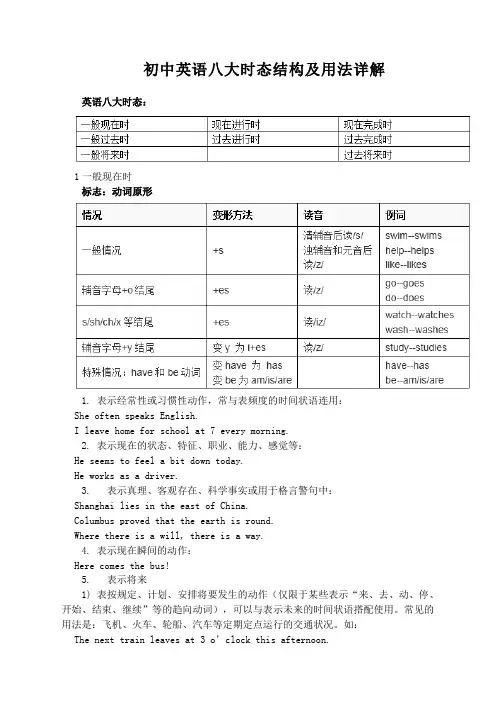
初中英语八大时态结构及用法详解英语八大时态:1一般现在时标志:动词原形1. 表示经常性或习惯性动作,常与表频度的时间状语连用:She often speaks English.I leave home for school at 7 every morning.2. 表示现在的状态、特征、职业、能力、感觉等:He seems to feel a bit down today.He works as a driver.3. 表示真理、客观存在、科学事实或用于格言警句中:Shanghai lies in the east of China.Columbus proved that the earth is round.Where there is a will, there is a way.4. 表示现在瞬间的动作:Here comes the bus!5. 表示将来1) 表按规定、计划、安排将要发生的动作(仅限于某些表示“来、去、动、停、开始、结束、继续”等的趋向动词),可以与表示未来的时间状语搭配使用。
常见的用法是:飞机、火车、轮船、汽车等定期定点运行的交通状况。
如:The next train leaves at 3 o’clock this afternoon.How often does the shuttle bus run?2) 在时间和条件状语从句中常使用一般现在时表示将来发生的事情:When Bill comes (不用will come), ask him to wait for me.I shall go there tomorrow unless I’m too busy.2一般过去时标志:动词过去式*闭音节:元音字母a, e, i, o, u如果发字母本来的音则称为开音节,否则称为闭音节。
1. 表示过去某时所发生的动作或存在的状态,常与表示过去的时间状语连用(e.g. yesterday, this morning, just now, a moment ago, in May, last night / year / week, once upon a time, the other day, before …, when …, in the past等)。
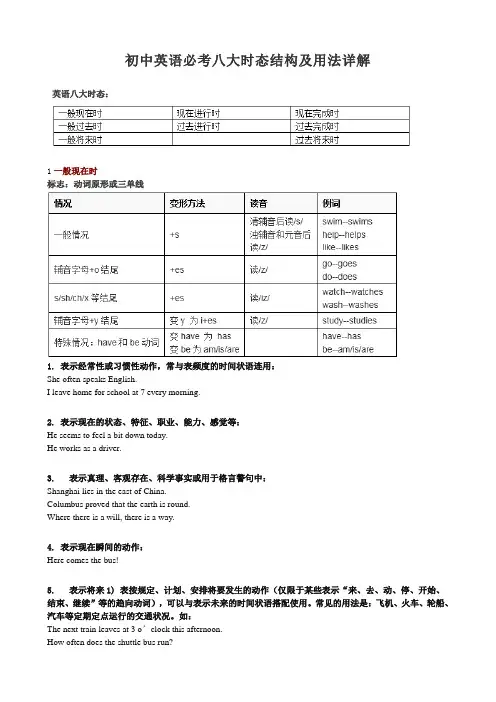
初中英语必考八大时态结构及用法详解英语八大时态:1一般现在时标志:动词原形或三单线1. 表示经常性或习惯性动作,常与表频度的时间状语连用:She often speaks English.I leave home for school at 7 every morning.2. 表示现在的状态、特征、职业、能力、感觉等:He seems to feel a bit down today.He works as a driver.3. 表示真理、客观存在、科学事实或用于格言警句中:Shanghai lies in the east of China.Columbus proved that the earth is round.Where there is a will, there is a way.4. 表示现在瞬间的动作:Here comes the bus!5. 表示将来1) 表按规定、计划、安排将要发生的动作(仅限于某些表示“来、去、动、停、开始、结束、继续”等的趋向动词),可以与表示未来的时间状语搭配使用。
常见的用法是:飞机、火车、轮船、汽车等定期定点运行的交通状况。
如:The next train leaves at 3 o’clock this afternoon.2) 在时间和条件状语从句中常使用一般现在时表示将来发生的事情:When Bill comes (不用will come), ask him to wait for me.I shall go there tomorrow unless I’m too busy.2一般过去时标志:动词过去式*闭音节:元音字母a, e, i, o, u如果发字母本来的音则称为开音节,否则称为闭音节。
1. 表示过去某时所发生的动作或存在的状态,常与表示过去的时间状语连用(e.g. yesterday, this morning, just now, a moment ago, in May, last night / year / week, once upon a time, the other day, before …, when …, in the past等)。
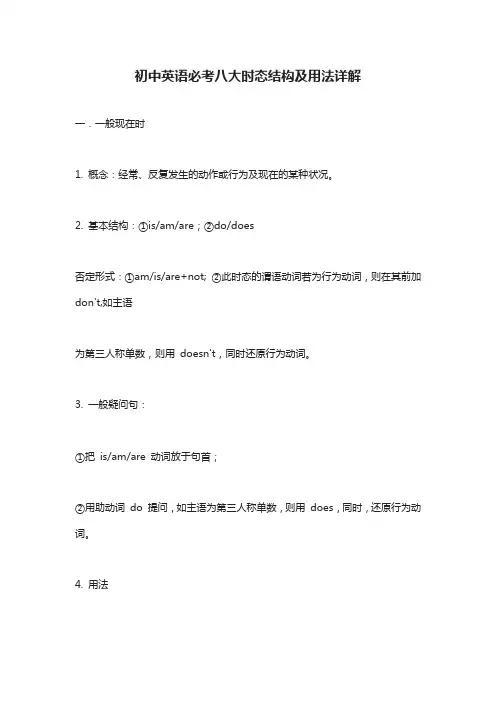
初中英语必考八大时态结构及用法详解一.一般现在时1. 概念:经常、反复发生的动作或行为及现在的某种状况。
2. 基本结构:①is/am/are;②do/does否定形式:①am/is/are+not; ②此时态的谓语动词若为行为动词,则在其前加don't,如主语为第三人称单数,则用doesn't,同时还原行为动词。
3. 一般疑问句:①把is/am/are 动词放于句首;②用助动词do 提问,如主语为第三人称单数,则用does,同时,还原行为动词。
4. 用法1)经常性或习惯性的动作,常与表示频度的时间状语连用。
例如:I leave home for school at 7 every morning. 每天早上我七点离开家。
2)客观真理,客观存在,科学事实。
例如:The earth moves around the sun. 地球绕太阳转动。
Shanghai lies in the east ofChina. 上海位于中国东部。
3)表示格言或警句。
例如:Pride goes before a fall 骄者必败。
注意:此用法如果出现在宾语从句中,即使主句是过去时,从句谓语也要用一般现在时。
例如:Columbus proved that the earth is round. 哥伦布证实了地球是圆的。
4)现在时刻的状态、能力、性格、个性。
例如:I don't want so much. 我不要那么多。
Ann writes good English but does not speak well.安英语写得不错,讲的可不行。
5)一般现在时表示将来含义。
a. 下列动词come, go, arrive, leave, start, begin, return 的一般现在时可以表示将来,主要用来表示在时间上已确定或安排好的事情。
例如:The train leaves at six tomorrow morning. 火车明天上午六点开。
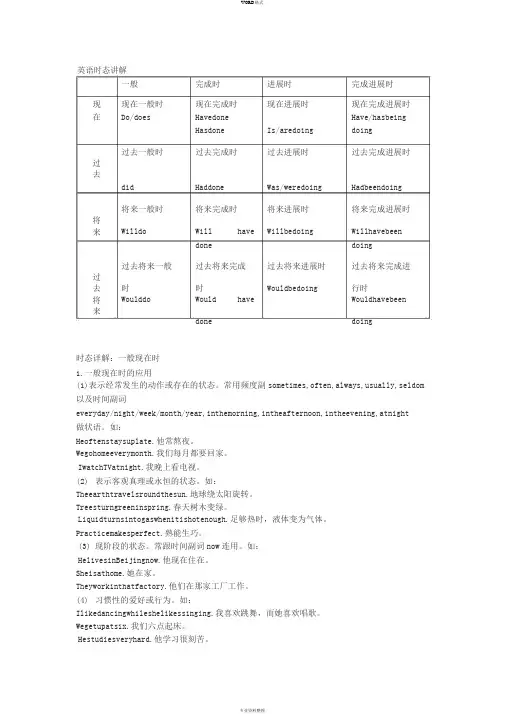
英语时态讲解一般完成时进展时完成进展时现现在一般时现在完成时现在进展时现在完成进展时在Do/does Havedone Have/hasbeingHasdone Is/aredoing doing过去一般时过去完成时过去进展时过去完成进展时过去did Haddone Was/weredoing Hadbeendoing将来一般时将来完成时将来进展时将来完成进展时将Willdo Will have Willbedoing Willhavebeen 来done doing过去将来一般过去将来完成过去将来进展时过去将来完成进过Wouldbedoing去时时行时将Woulddo Would have Wouldhavebeen 来done doing时态详解:一般现在时1.一般现在时的应用(1)表示经常发生的动作或存在的状态。
常用频度副sometimes,often,always,usually,seldom 以及时间副词everyday/night/week/month/year,inthemorning,intheafternoon,intheevening,atnight做状语。
如:Heoftenstaysuplate.他常熬夜。
Wegohomeeverymonth.我们每月都要回家。
IwatchTVatnight.我晚上看电视。
(2)表示客观真理或永恒的状态。
如:Theearthtravelsroundthesun.地球绕太阳旋转。
Treesturngreeninspring.春天树木变绿。
Liquidturnsintogaswhenitishotenough.足够热时,液体变为气体。
Practicemakesperfect.熟能生巧。
(3)现阶段的状态。
常跟时间副词now连用。
如:HelivesinBeijingnow.他现在住在。
Sheisathome.她在家。
Theyworkinthatfactory.他们在那家工厂工作。
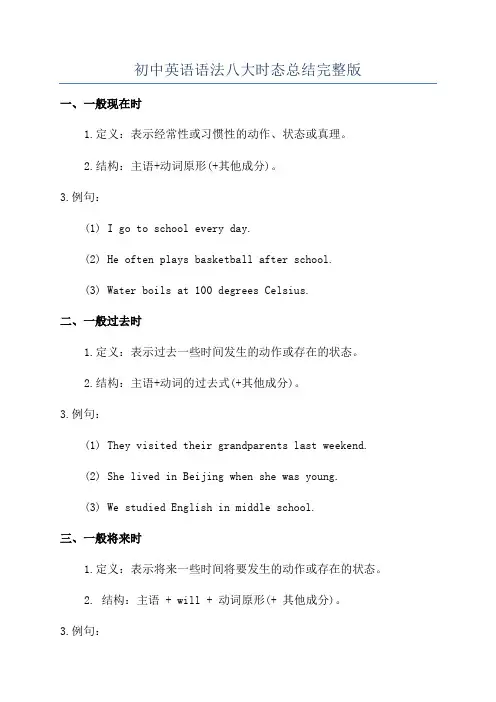
初中英语语法八大时态总结完整版一、一般现在时1.定义:表示经常性或习惯性的动作、状态或真理。
2.结构:主语+动词原形(+其他成分)。
3.例句:(1) I go to school every day.(2) He often plays basketball after school.(3) Water boils at 100 degrees Celsius.二、一般过去时1.定义:表示过去一些时间发生的动作或存在的状态。
2.结构:主语+动词的过去式(+其他成分)。
3.例句:(1) They visited their grandparents last weekend.(2) She lived in Beijing when she was young.(3) We studied English in middle school.三、一般将来时1.定义:表示将来一些时间将要发生的动作或存在的状态。
2. 结构:主语 + will + 动词原形(+ 其他成分)。
3.例句:(1) I will go to the park tomorrow.(3) We will have a party next week.四、现在进行时1.定义:表示现在正在进行的动作。
2. 结构:主语 + am/is/are + 动词-ing(+ 其他成分)。
3.例句:(1) She is reading a book right now.(2) They are playing soccer in the park.(3) We are having dinner at the moment.五、过去进行时1.定义:表示过去一些时间正在进行的动作。
2. 结构:主语 + was/were + 动词-ing(+ 其他成分)。
3.例句:(1) He was watching TV at 8 o'clock last night.(2) They were traveling in Europe during summer vacation.(3) We were studying when the phone rang.六、将来进行时1.定义:表示将来一些时间正在进行的动作。
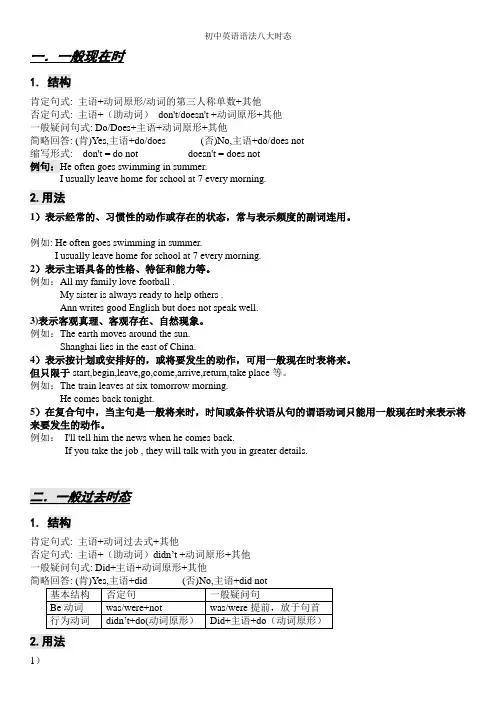
初中英语语法八大时态一.一般现在时1.结构肯定句式: 主语+动词原形/动词的第三人称单数+其他否定句式: 主语+(助动词)don't/doesn't +动词原形+其他一般疑问句式: Do/Does+主语+动词原形+其他简略回答: (肯)Yes,主语+do/does (否)No,主语+do/does not缩写形式: don't = do not doesn't = does not例句:He often goes swimming in summer.I usually leave home for school at 7 every morning.2.用法1)表示经常的、习惯性的动作或存在的状态,常与表示频度的副词连用。
例如: He often goes swimming in summer.I usually leave home for school at 7 every morning.2)表示主语具备的性格、特征和能力等。
例如:All my family love football .My sister is always ready to help others .Ann writes good English but does not speak well.3)表示客观真理、客观存在、自然现象。
例如:The earth moves around the sun.Shanghai lies in the east of China.4)表示按计划或安排好的,或将要发生的动作,可用一般现在时表将来。
但只限于start,begin,leave,go,come,arrive,return,take place等。
例如:The train leaves at six tomorrow morning.He comes back tonight.5)在复合句中,当主句是一般将来时,时间或条件状语从句的谓语动词只能用一般现在时来表示将来要发生的动作。
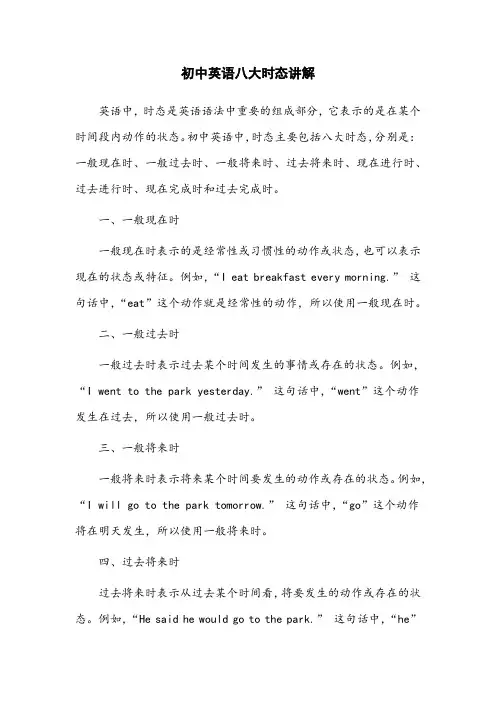
初中英语八大时态讲解英语中,时态是英语语法中重要的组成部分,它表示的是在某个时间段内动作的状态。
初中英语中,时态主要包括八大时态,分别是:一般现在时、一般过去时、一般将来时、过去将来时、现在进行时、过去进行时、现在完成时和过去完成时。
一、一般现在时一般现在时表示的是经常性或习惯性的动作或状态,也可以表示现在的状态或特征。
例如,“I eat breakfast every morning.”这句话中,“eat”这个动作就是经常性的动作,所以使用一般现在时。
二、一般过去时一般过去时表示过去某个时间发生的事情或存在的状态。
例如,“I went to the park yesterday.”这句话中,“went”这个动作发生在过去,所以使用一般过去时。
三、一般将来时一般将来时表示将来某个时间要发生的动作或存在的状态。
例如,“I will go to the park tomorrow.”这句话中,“go”这个动作将在明天发生,所以使用一般将来时。
四、过去将来时过去将来时表示从过去某个时间看,将要发生的动作或存在的状态。
例如,“He said he would go to the park.”这句话中,“he”认为“he would go to the park”是未来要发生的事情,所以使用过去将来时。
五、现在进行时现在进行时表示正在进行的动作或存在的状态。
例如,“I am eating an apple.”这句话中,“eating”这个动作正在进行,所以使用现在进行时。
六、过去进行时过去进行时表示过去某个时间正在进行的动作或存在的状态。
例如,“She said she was watching TV at 8 o’clock last night.”这句话中,“watching TV”这个动作在昨晚8点正在进行,所以使用过去进行时。
七、现在完成时现在完成时表示过去发生的动作对现在造成的影响或结果,也可以表示持续到现在的动作或状态。
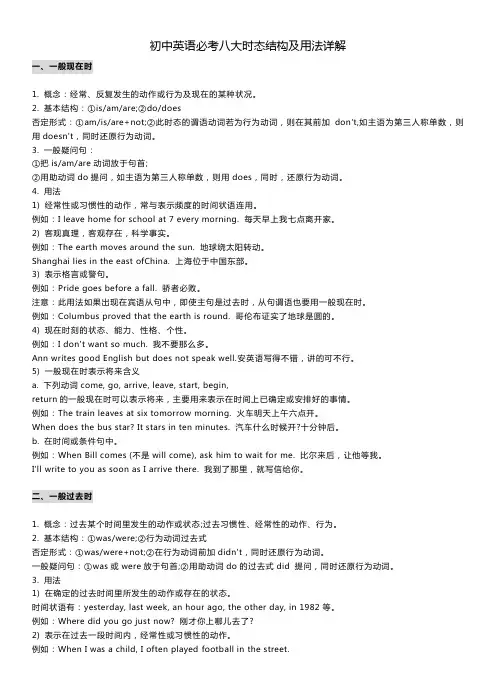
初中英语必考八大时态结构及用法详解一、一般现在时1. 概念:经常、反复发生的动作或行为及现在的某种状况。
2. 基本结构:①is/am/are;②do/does否定形式:①am/is/are+not;②此时态的谓语动词若为行为动词,则在其前加don't,如主语为第三人称单数,则用doesn't,同时还原行为动词。
3. 一般疑问句:①把is/am/are动词放于句首;②用助动词do提问,如主语为第三人称单数,则用does,同时,还原行为动词。
4. 用法1) 经常性或习惯性的动作,常与表示频度的时间状语连用。
例如:I leave home for school at 7 every morning. 每天早上我七点离开家。
2) 客观真理,客观存在,科学事实。
例如:The earth moves around the sun. 地球绕太阳转动。
Shanghai lies in the east ofChina. 上海位于中国东部。
3) 表示格言或警句。
例如:Pride goes before a fall. 骄者必败。
注意:此用法如果出现在宾语从句中,即使主句是过去时,从句谓语也要用一般现在时。
例如:Columbus proved that the earth is round. 哥伦布证实了地球是圆的。
4) 现在时刻的状态、能力、性格、个性。
例如:I don't want so much. 我不要那么多。
Ann writes good English but does not speak well.安英语写得不错,讲的可不行。
5) 一般现在时表示将来含义a. 下列动词come, go, arrive, leave, start, begin,return的一般现在时可以表示将来,主要用来表示在时间上已确定或安排好的事情。
例如:The train leaves at six tomorrow morning. 火车明天上午六点开。
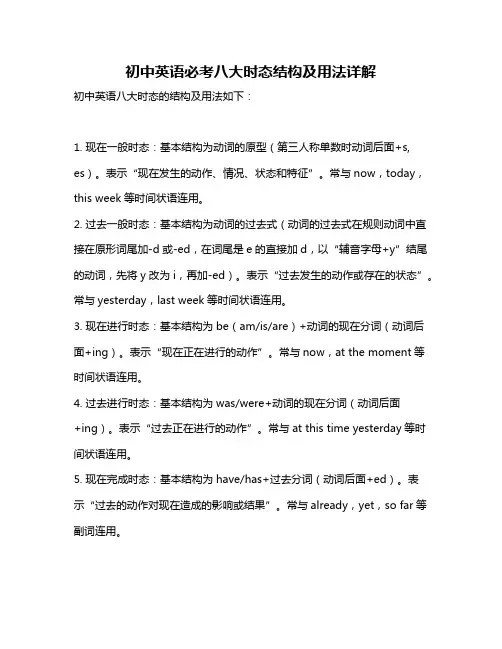
初中英语必考八大时态结构及用法详解初中英语八大时态的结构及用法如下:1. 现在一般时态:基本结构为动词的原型(第三人称单数时动词后面+s, es)。
表示“现在发生的动作、情况、状态和特征”。
常与now,today,this week等时间状语连用。
2. 过去一般时态:基本结构为动词的过去式(动词的过去式在规则动词中直接在原形词尾加-d或-ed,在词尾是e的直接加d,以“辅音字母+y”结尾的动词,先将y改为i,再加-ed)。
表示“过去发生的动作或存在的状态”。
常与yesterday,last week等时间状语连用。
3. 现在进行时态:基本结构为be(am/is/are)+动词的现在分词(动词后面+ing)。
表示“现在正在进行的动作”。
常与now,at the moment等时间状语连用。
4. 过去进行时态:基本结构为was/were+动词的现在分词(动词后面+ing)。
表示“过去正在进行的动作”。
常与at this time yesterday等时间状语连用。
5. 现在完成时态:基本结构为have/has+过去分词(动词后面+ed)。
表示“过去的动作对现在造成的影响或结果”。
常与already,yet,so far等副词连用。
6. 过去完成时态:基本结构为had+过去分词(动词后面+ed)。
表示“过去的动作在过去的某个时间之前已经完成或发生的动作或存在的状态”。
常与by the end of last year,by the time of等时间状语连用。
7. 现在完成进行时态:基本结构为have/has been+动词的现在分词(动词后面+ing)。
表示“动作从过去某时开始,一直延续到现在,或者刚刚完成”。
常与for several days,since等时间状语连用。
8. 过去完成进行时态:基本结构为had been+动词的现在分词(动词后面+ing)。
表示“过去的某个动作从过去某时开始,一直延续到过去的某个时间,或者刚刚完成”。
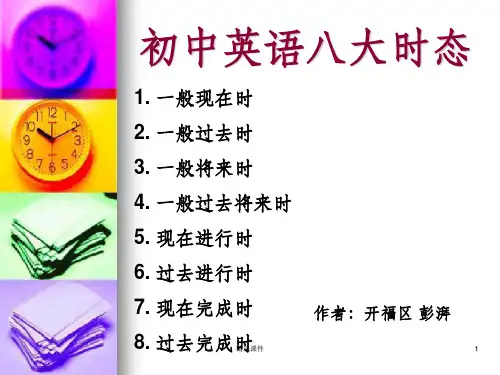
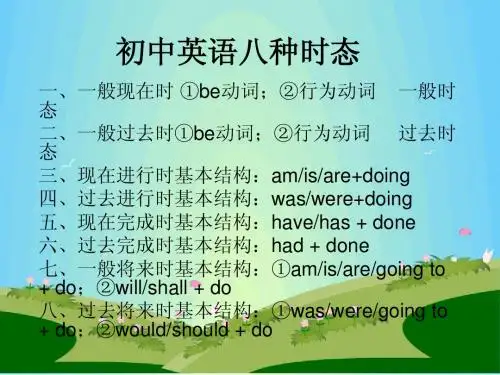
初中英语时态讲解初中阶段,要求学生掌握动词六种时态的基本结构(一般现在时,一般过去时,现在进行时,过去进行时,现在完成时和一般将来时态)及它们的主要用法和区别。
了解过去将来、过去完成时态的基本用法,解题时注意找出关键词,正确判断出时态,按时态结构正确变化动词。
注意句子时态的一致性,注意对特殊时态的处理。
1、一般现在时。
一般现在时通常表示目前阶段经常发生的动作或存在的状态。
通常用“usually, often, every day, sometimes”。
结构:1)be动词。
有一顺口溜:我用am ,你用 are ,is 用于他,她,它, 单数is,复数are.肯定式:主语+ am /is/are +其他否定式:主语+ am/is/are +not + 其他疑问式:Am /Is /Are + 主语+ 其他简略回答: (肯) Yes,主语 + am/ is /are(否) No,主语 + am /is/are not2)行为动词(实义动词)除主语是第三人称单数外,都用动词原形,主语是第三人称单数时,在动词词尾加-s或-es 。
“动词第三人称单数”的加法即“如何从动词原形变为第三人称单数”1、一般情况加s.2、以o, s, x, ch, sh 结尾加es.3、以“辅音字母+y”结尾改y为i +es肯定式:主语+动词原形/动词的第三人称单数否定式:主语+助动词 don't/doesn't +动词原形+其他疑问式:Do/Does+主语+动词原形+其他简略回答:(肯)Yes,主语+do/does (否)No,主语+do/does not缩写形式: don't == do not doesn't ==does not 注意:have的第三人称单数为has用法:1.表示事实,现状,性质或经常的,习惯的动作,常与often, usually, always, sometimes, today,every day,once a week, every five minutes, on Sundays等时间状语连用, eg. He hasa brother.2.表示普遍真理. eg. The earth goes round the sun.3.表示在现在时间里所发生的一个动作 . eg. Here comes the train.4.在时间和条件状语从句中代表一般将来时 . 'll go with you if you are free tomorrow.一般现在时用法专练:一、用括号内动词的适当形式填空。
初中英语所有时态1.一般现在时(do/does; is/am/are)①表示现在的情况、状态或特征。
例:He is a student.他是一个学生。
②表示经常性、习惯性动作。
例:He always helps others.他总是帮助别人。
③客观事实和普遍真理。
例:The earth moves the sun.地球绕着太阳转。
④表示一个按规定、计划或安排要发生的动作。
仅限于某些表示“来、去、动、停、开始、结束、继续”等的动词,可以与表示未来时间的状语搭配使用。
常见的用法是:飞机、火车、轮船、汽车等定期定点运行的交通方式。
例:The next train leaves at 3 o'clock this afternoon.下一趟火车今天下午3点开车。
⑤在时间、条件和让步状语从句中经常用一般现在(有时也用现在完成时)表示将的来事情。
(即:主将从现原则)例:I will call you as soon as I arrive at the airport.我一到机场就会给你打电话。
When you have finished the report, I will have waited for about 3 hours.等你完成这份报告的时候,我就已经等了将近3个小时了。
2. 现在进行时(am/is/are doing)①表示此时此刻正在发生的事情。
例:He is listning to the music now.他现在正在听音乐。
②表示目前一段时间内一直在做的事情,但不一定此时此刻正在做。
例:I am studying computer this term.这个学期我一直在学习计算机。
③现在进行时可以表示将来的含义。
瞬时动词的进行一定表将来。
例:I am leaving.我要离开了。
持续动词的进行只有有将来的时间状语或有将来语境中才表将来。
例:I am travelling next month.下个月我要去旅行。
英语八大时态讲解动词的时态有很多。
初中阶段主要掌握八种:一般现在时、一般过去时、现在进行时、过去进行时、一般将来时、过去将来时、现在完成时、过去完成时。
(一一般现在时1一般现在时态的构成:主语是I, we, you, they和名词复数时作谓语的行为动词用原形。
主语是he, she , it和名词单数时,作谓语的行为动词的词尾变化如下:一般情况+s以s, x, ch, sh 或o结尾+es以辅音+y结尾去y变i+es2一般现在时态的肯定句、否定句和疑问句形式(以be和like为例:He/ She is a student.I / We/ You/ They/ like music.Many people like music. I am not a student.Is he/ she a student?Do you/ they like music?Do many people like music?3一般现在时态的用法:现阶段经常性,习惯性的动作。
例如:I get up at six every morning.He plays tennis once a week.举例:A 现在的状态My mother is a teacher. She teaches English in a school.B 客观真理The earth goes around the sun.4常用于一般现在时态的时间状语:often usually sometimes always every day never in the morning 等。
例题解析:举一反三,学的更轻松!1. --- May I help you, sir?--- Yes, I bought the TV the day before yesterday, but it ______.A. didn’t workB. doesn’t workC. won’t workD. can’t work解析:电视虽然是前天买的,但坏了是现在的状态,应该用一般现在时态。
初中英语必考八大时态结构及用法详解一、一般现在时(Simple Present Tense):用法1:表示经常性的、重复性的动作或状态,相当于中文的“经常/总是/通常/偶尔……”。
例句:1. I often go hiking on weekends.(我经常在周末去远足。
)2. They usually play soccer after school.(他们放学后通常踢足球。
)用法2:表示客观真理、科学道理或普遍规律。
例句:1. Water boils at 100 degrees Celsius.(水沸腾时的温度是100摄氏度。
)2. The sun rises in the east and sets in the west.(太阳东升西落。
)二、一般过去时(Simple Past Tense):用法1:表示过去一些时间发生的动作或存在的状态。
例句:1. We went to the beach yesterday.(昨天我们去了海滩。
)2. They lived in London last year.(去年他们住在伦敦。
)用法2:表示过去经常性或重复性的动作。
例句:1. When I was young, I often played hide-and-seek with my friends.(我小时候经常和朋友们玩捉迷藏。
)2. He used to visit his grandparents every summer.(他过去每个夏天都去看望他的祖父母。
)三、一般将来时(Simple Future Tense):用法1:表示将来发生的动作或存在的状态。
例句:1. I will go to the movie tonight.(今晚我将去看电影。
)2. She is going to visit her grandparents next month.(她下个月打算去看望她的祖父母。
初中英语八种时态归纳复习(一)一般现在时(一)定义表示经常性或习惯性的动作,或存在的状态,还表示主语具备的性格和能力及客观真理。
例:I get up at 6:30 in the morning . She is at home .(二)构成主要用动词原形表示,当主语是第三人称单数时,在动词词尾加s/es。
(三)句型1、肯定句:主语+谓语+其他。
She reads English everyday.2、否定句:主语+don’t/doesn’t+谓语+其他。
He doesn’t get up at 6:30 in the morning.3、一般疑问句:Do/Does+主语+V原+其他?Do you like English? Yes, I do. /No, I don’t.4、特殊疑问句:特殊疑问词+do/does+主语+V原+其他?What time do you get up every morning?Where does your father work?(三)用法1、表示经常性或习惯性的动作,或存在的状态,带与表示频率的时间状语如:often , sometimes , usually,always , everyday year,month...), once/twice a week (month, year, etc.), seldom, on Sundays等连用。
I leave home for school at seven every morning.2、表示客观真理,科学事实、格言警句。
The sun rises in the east .日出东方。
The earth goes around the sun .地球绕着太阳转。
Ten minus two is eight.十减二等于八。
Light travels faster than sound .光的速度比声音的速度快。
初中英语时态详解一、什么叫时态?英语中不同时间发生的动作要用动词的不同形式来表示,这种动词的不同形式叫做时态。
二、时态的种类常见的英语时态有16种,但初中阶段一般要求掌握9种。
请见下表:(以动词work为例)时态名称例句主语谓语时间状语一般现在时He worksevery day 一般过去时Heworkedyesterday 一般将来时Hewill workto morrow 过去将来时Hesaid he would workthe next day现在进行时Heis workingnow过去进行时Hewas workingat that time现在完成时Hehas workedfor two hours过去完成时Hehad workedfor two hours by then现在完成进行时Hehas been workingheresince10 years ago时态往往和其时间状语有着密切的联系。
现就常用9种时态及其常用时间状语等问题分别简介于下:1、一般现在时一般现在时用来表示:a、客观事实和普遍真理;b、习惯性的、反复出现的动作或状态;c、主语现有的特征。
常与下列时间状语连用:(1)always, often, usually, sometimes, seldom, ever, never等。
如:It never snows in Australia in December、澳大利亚的二月里从来不下雪。
(2)once a year, twice a day, every day, every month, every other day(每隔一天),every two days(每隔两天)等。
如:I hear from her every other week、我每隔一周收到她的来信。
(3)有时可与表示未来的时间状语连用,表达按一定规定、计划或安排要发生的情况,此类状语有:at11:30, tomorrow, tonight, now等。
如:Where do we go now?我们现在到哪儿去?2、现在进行时现在进行时表示说话时或目前阶段正在进行的动作。
常与下列时间状语连用:now, this month, today,at7:30 等。
如:It’s raining now、现在正在下雨。
He’s looking after his brother today、他今天在照看弟弟。
现在进行时多数情况下没有具体的时间状语,一般通过上下文显示动作正在进行。
如:Who are you waiting for?你在等谁?They are listening to an English talk、他们在听一个英语报告。
3、一般过去时一般过去时表示过去发生的动作或状态。
用于一般过去时的时间状语有:(1)then, at that time, at that moment, just now, just then, recently等。
如:Tom was here just now、汤姆刚才在这儿。
(2)yesterday, yesterday morning(afternoon, evening), last night, last week(month, year, Sunday, January)等。
如:I wasn’t last night、昨天晚上我不在家。
(3)during the war, a few days(months, years)ago等。
如:I went to the town a few days ago、几天前我去了城里一趟。
(4)由when, while, before, after, whenever等引导的表示过去时间的状语从句。
如:When he came back, he found a note on his desk、当他回来时,看见书桌上有一张字条。
(5)“in(on或at)+一个过去的时间”,如in1976, on the evening of May4th, at9:00等。
如:She was born in1968、她出生于1968年。
4、一般将来时一般将来时表示将要发生的动作或存在的状态。
常与表示将来时间的状语连用。
如:(1)tomorrow, today, tonight;(2)next spring, next month;(3)during the holidays, during this term;(4)at12:30;(5)by then, by Sunday;(6)first, next;(7)when I grow up等。
如:Who is going to speak first?谁先发言?He is going to be a doctor when he grows up、他长大以后要当医生。
5、过去将来时过去将来时指的是立足于过去某时,从过去的观点看将来发生的动作。
常用的时间状语有:(1)the next day, that day(night);(2)the following week;(3)last week;(4)at11:50;(5)by then;(6)first, next;(7)when he grew up, after is stopped raining等。
如:We were going to have a football match that day, but it rained、那天我们准备进行一场足球赛,但下雨了。
6、过去进行时过去进行时表示过去某一时刻(候)正在进行的动作。
常用的时间状语有:(1)at8:00 last night, this time yesterday;(2)when I saw him, while I was reading a novel;(3)last year, yesterday morning;(4)from seven to nine等。
如:What were you doing at ten yesterday?昨天点钟你在干什么?They were watching TV whenI got there、我到那儿时他们在看电视。
7、现在完成时现在完成时表示过去发生的某一动作对现在造成的结果或影响,也可指过去开始延续到现在的动作或状态。
常用的时间状语有:(1)now, today, tonight, this week(year)等。
如:I have had a clock now、我现在有一个闹钟了。
(2)yet, already, just, recently等。
如:Have you already posted the photos?你把照片寄走了吗?(3)由since引导的时间状语或时间状语从句。
如:Great changes have taken place in my hometown since liberation、解放以来,我的家乡发生了巨大的变化。
(4)由for构成的表示一段时间的状语。
如:He has been away from Beijing for two months、他已离开北京两个月了。
8、过去完成时过去完成时表示过去某一动作或时间以前已发生或完成的动作,也可指从过去某时开始到过去另一时为止的动作或状态,即“过去的过去”。
常用的时间状语有:(1)before he came here, when I got there、等。
如:The meeting had begun when we got there、我们到那儿时,会议已经开始了。
(2)by last month, by the end of last year(June)等。
如:We had learned about1,200 English words by the end oflast term、到上学期期末为止,我们已学习了大约1,200个英语单词。
9、现在完成进行时1、定义现在完成进行时表示动作从过去某一时间开始,一直延续到现在,可能还要继续下去。
2、现在完成进行时的构成现在完成进行时是由“have/has+been+动词的现在分词”构成3、现在完成进行时的基本句型肯定式疑问式简略回答I have been working、Have you been working?Yes, I/we have、No, I/we havent、He/She/It has been working、Hashe/she/it been working?Yes, he/she/it has、No, he/she/it hasnt、We/You/They have been working、Have they been working?Yes, they have、No, they havent、注:现在完成进行时基本上没有否定结构4 现在完成时的语法作用(1)在强调指出动作还未结束,还要继续下去。
如:Ive been reading this book for two hours, but I havent finished it、这本书我已读了两个小时了,但我还没读完。
Ive read this book、我已读完这本书了。
(2)强调动作延续时间的长久或带感情色彩。
She has always been working like that、她一贯是这样工作的。
(3)动作不包含持续意义的动作,要表示延续到现在的动作,要用现在完成进行时。
Theyve beenbuilding a ship、(在进行)他们一直在造一艘船。
(4)现在完成进行时也可表示现在以前这段时间反复发生的事情。
Weve been seeing quite a lot of each other recently、最近我们经常见面。
三、几种常用时态的用法比较1、一般现在时与现在进行时的用法比较(1)一般现在时用以说明客观事实或情况,或用于强调动作的永久性、经常性或反复性。
而现在进行时强调动作正在进行,因此它不仅表示动作是暂时的(即动作的持续时间是有限的),而且这种动作常含有未完成性。
试比较:The old man writes children’s stories、那位老人是写儿童小说的。
(说明客观事实)The old man is now writing a story、那位老人现在正在编写一个故事。
(描述正在进行的动作)She is kind、她很善良。
(指她一贯心地善良)She is being kind、她现在显得很善良。
(表示暂时性,平时她并不善良)John types his own letters、约翰自己用打字机打信。